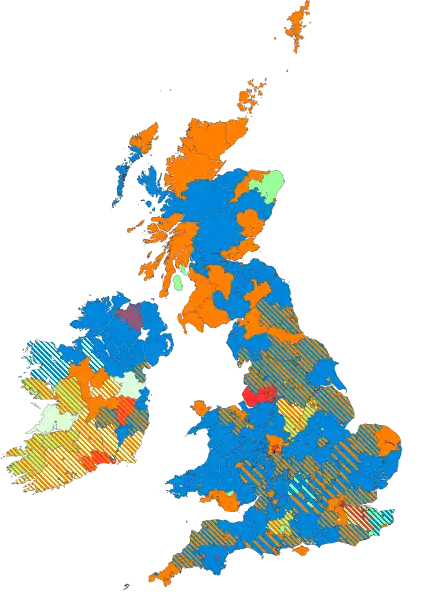| ||||||||||||||||||||||||||||||||||
All 654 seats in the House of Commons 328 seats needed for a majority | ||||||||||||||||||||||||||||||||||
|---|---|---|---|---|---|---|---|---|---|---|---|---|---|---|---|---|---|---|---|---|---|---|---|---|---|---|---|---|---|---|---|---|---|---|
| ||||||||||||||||||||||||||||||||||
 Colours denote the winning party—as shown in § Results | ||||||||||||||||||||||||||||||||||
| ||||||||||||||||||||||||||||||||||
In the 1857 United Kingdom general election, the Whigs, led by Lord Palmerston, won a majority in the House of Commons as the Conservative vote fell significantly. The election had been provoked by a vote of censure in Palmerston's government over his approach to the Arrow affair which led to the Second Opium War.
There is no separate tally of votes or seats for the Peelites. They did not contest elections as an organised party but more as independent Free trade Conservatives with varying degrees of distance from the two main parties.
According to A. J. P. Taylor:
- The general election of 1857 is unique in our history: the only election ever conducted as a simple plebiscite in favour of an individual. Even the "coupon" election of 1918 claimed to be more than a plebiscite for Lloyd George; even Disraeli and Gladstone offered a clash of policies as well as of personalities. In 1857 there was no issue before the electorate except whether Palmerston should be Prime Minister; and no one could pretend that Palmerston had any policy except to be himself.[2]
Results

| UK General Election 1857 | |||||||||||||||
|---|---|---|---|---|---|---|---|---|---|---|---|---|---|---|---|
| Party | Candidates | Votes | |||||||||||||
| Stood | Elected | Gained | Unseated | Net | % of total | % | No. | Net % | |||||||
| Whig | 507 | 377 | +53 | 57.65 | 64.77 | 464,127 | +7.0 | ||||||||
| Conservative | 351 | 264 | −66 | 40.37 | 33.45 | 239,712 | −7.1 | ||||||||
| Independent Irish | 13 | 1.99 | 1.69 | 12,099 | |||||||||||
| Chartist | 1 | 0 | 0 | 0 | 0 | 0 | 0.1 | 614 | −0.1 | ||||||
Summary
Seats summary
See also
Notes
References
Further reading
- Craig, F. W. S. (1989), British Electoral Facts: 1832–1987, Dartmouth: Gower, ISBN 0900178302
- Rallings, Colin; Thrasher, Michael, eds. (2000), British Electoral Facts 1832–1999, Ashgate Publishing Ltd
External links
This article is issued from Wikipedia. The text is licensed under Creative Commons - Attribution - Sharealike. Additional terms may apply for the media files.

.jpg.webp)